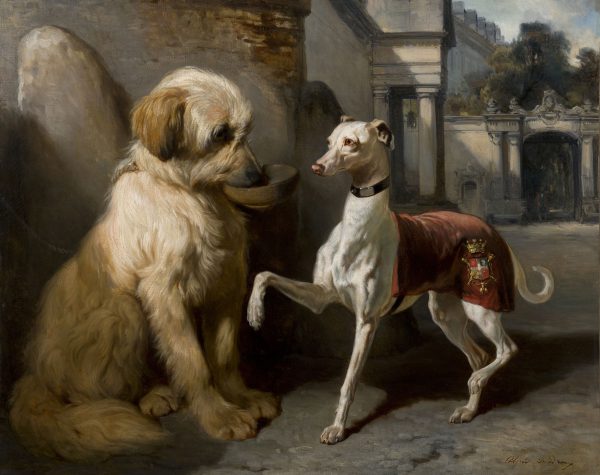Rich and Poor, 1845
Oil on canvas, H. 0.70 m; W. 0.9 m
Signed lower right: Alfred De Dreux.
Provenance: Private collection.
Jeanne Doin, « Alfred de Dreux (1810-1860) », Gazette des Beaux-Arts, vol. 63, October 1921, p. 244.
Marie-Christine Renauld, L’Univers d’Alfred De Dreux, 1810-1860, suivi du catalogue raisonné, Arles, 2008, p. 121
Alfred de Dreux, who studied under Léon Cogniet and was a fervent admirer of Delacroix, also had close ties with Théodore Géricault, whose equestrian paintings had a decisive influence on his works. In 1831, de Dreux exhibited Intérieur d’écurie (“Interior of a Stable”) at the Salon in Paris, which immediately earned him a reputation among collectors and critics alike. He was thus taken in by the French and British nobility, who appreciated the elegance of his works. He counted the Duke of Orléans, the Duke of Aumale and Queen Victoria among his patrons. In 1840, he began his famous series of portraits of horses from the renowned stables of the Duke of Orléans. This Parisian dandy, a chronicler of the hunt, of officers on horseback, of races and elegant riding habits, thereby became one of the most prominent figures in society under Louis-Philippe I and Napoleon III.
Over the course of his numerous trips to England, Alfred de Dreux had the opportunity to deepen his studies of animal painters from across the Channel, and developed an affinity for painting purebred dogs. He had undoubtedly known the works of Erwin Landseer (1802-1873). The similarities between our painting and Landseer’s pendants, entitled Low Life – High Life (Proletariat – Aristocracy), exhibited in 1831 at the British Institution and found today at the Tate Gallery, are indeed striking. Title and idea are hereby intertwined, falling within a long tradition, both literary and pictorial, of juxtaposing two characters and thereby offering food for thought.
In our piece, the artist depicts two dogs belonging to different worlds, and plays on the contrasts. A slender Greyhound, the paragon of a refined dog of pedigree, wearing a leather collar and a garnet-coloured jacket adorned with its master’s coat of arms, elegantly extends a paw to its counterpart. The latter, a robust dog, probably a mutt, with a common rope as a leash, holds out its wooden bowl. The difference between the two dogs is reinforced by the division of space: a beautiful mansion on the right, and a simple brick wall on the left.
